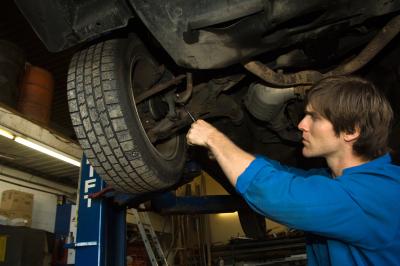
To replace the control arm bushings from your vehicle, you will need to remove the control arm(s). The exact procedure varies from one car model to another and requires some special tools. However, in most cases, you will be able to rent the necessary tools for the job from your local auto parts store. This is a general procedure and applies to most vehicles. However, if you need specific details, consult the vehicle service manual for your particular model.
Your car may be equipped with one or two control arms on each of the front wheel assemblies and one on each of the rear wheel assemblies. The bushings seat at the inner end of the front control arms, while the outer ends of both control arms hold to the steering knuckle assembly through a ball joint. A cotter pin and a castle nut lock the ball joint in place. However, the control arms on the rear suspension may come with inner and outer bushings.
In order to remove either control arm, you will need to temporarily press the coil spring at the strut assembly. You can use a spring compressor, ball joint separator and floor jack for support for this part of the job (see Resources for more information). On some models, you will need to detach the stabilizer bar and strut rod from the control arm.
With the outer end detached, you will be able to reach and unfasten the through bolts from the bushings at the inner end.
With the control arm(s) removed, you can use a vise to replace the bushings. Depending on their particular configuration, you may unscrew or press the old bushings from the control arm. If necessary, use a bushing driver to take off the old units.
When ready, re-install the control arms using the reverse order of removal. However, note that you will need to replace the cotter pin that locks the castle nut at the ball joint stud. Also, consult your particular vehicle service manual for the mounting hardware's proper torque.
With the control arms in place, you are ready to preload the control arm bushings. In most cases, the vehicle manufacturer asks you to lightly tighten the bushings through bolts and lower the front of your vehicle. The weight of the vehicle will then position the control arms in their most common angle in relation to the rest of the suspension.
Finally, you will need to torque the bushings through bolts to specification. You can do this by driving the wheel or wheels with the new arm bushings over a ramp and tightening the bushing mounting bolts to the specified torque using a torque wrench.